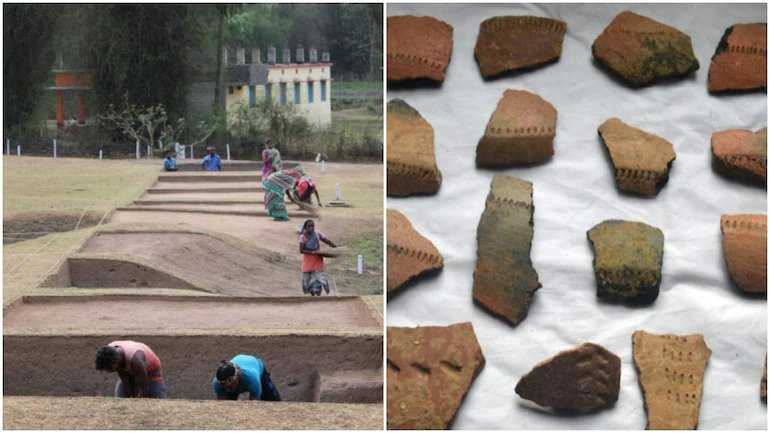4,000 Years old Settlement Discovered by Archaeologists in Odisha, India.

4,000 Years old Settlement Discovered by Archaeologists in Odisha, India.
Archaeologists have discovered a 4,000 Years old settlement and some ancient artefacts in Orissa Balasore District, reported by the Odisha Institute of Maritime and South-East Asian Studies(OIMSEAS)
OIMSEAS had Called for permission from the Archaeological Survey of India(ASI) to document the site at the Durgadevi Village in Remuna tehsil after uncovering traces of fortified Early historic sites near Balasore Town, Orissa.
As per the Archaeological Survey of India, the site has a circular mud fortification of about 4.9 km between the sona river to the south and the burahabalang river on its northeastern margin.
At the excavation site, archaeologists discovered distinct signs of three cultural periods: Chalcolithic (2000 BCE to 1000 BCE), Iron Age (1000 BCE to 400 BCE), and Early Historic Period (1000 BCE to 400 BCE) (400 BCE to 200 BCE).
“On its north and south sides, two small nullas, Gangahara and Prassana, link the site, producing a natural moat for the site, which was an ancient water management system built at least 4,000 years ago,” according to the university.
Excavation began with the goal of correlating the concurrent growth and development of maritime activities, as well as rapid urbanization, on India’s eastern seaboard, linking the Ganga valley in the north to the Mahanadi valley in central Odisha, with a special focus on early cultural development in northern Odisha, according to the research centre.
The horizontal excavation was concentrated in a two-acre region of high land, where a cultural deposit of roughly 4 to 5 metres was seen, according to the OIMSEAS.
Archaeologists discovered a human village as well as Chalcolithic period artefacts.
“The base of a circular hut, black on red painted pottery, black slipped ware, red slipped ware, and copper artefacts are the primary discoveries of Durgadevi’s Chalcolithic period. Sunil Kumar Pattnaik, archaeologist and Secretary of OIMSEAS, says the circular hut’s floor is rammed with red soil.

“The people’s lifestyle has been derived from the circular hut’s base and the utilitarian objects discovered. People had mostly settled down and had begun agriculture, animal husbandry, and fishing,” he explained.
Pottery, black burnished ware, black and redware, iron artefacts such as nails and arrowheads, and crucible and slag of various kinds are among the cultural material evidence and remnants discovered during this phase.
“In Odisha, particularly in north Odisha, the usage of iron is a watershed moment in the rise of civilisation. “Various archaeologists have unearthed multiple iron age sites in the upper and middle Mahanadi valley, but this is the first site in north Odisha,” Mr Patnaik said.
The site also yielded cultural artefacts from the early historic period, including redware pottery specimens, terracotta ear studs, bangles, beads, and other conical objects.
“From an agricultural background to trade and the construction of fortifications around the site with a moat, which reflect the emergence of urbanisation at Durgadevi circa 400 BCE to 200 BCE,” stated the OIMSEAS Secretary.